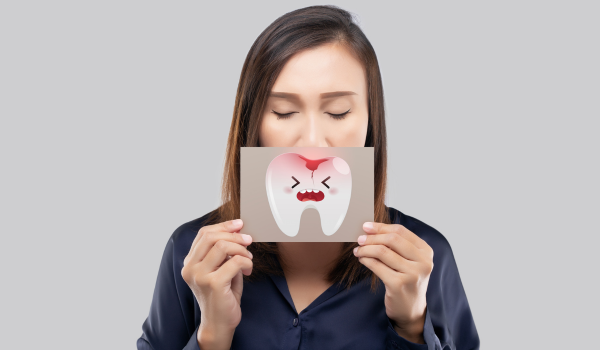.png)
Gum disease is a common yet serious condition that affects many people worldwide. It starts with gingivitis, a mild form of gum disease, and if left untreated, it can progress to periodontitis, a more severe form of the disease. Understanding the difference between gingivitis and periodontitis is crucial for recognizing the symptoms, identifying the causes, and seeking proper treatment. In this article, we will compare gingivitis and periodontitis, including their causes, symptoms, and treatment methods, to help you understand how to protect your oral health.
1. What is Gingivitis?
Gingivitis is the earliest stage of gum disease, characterized by inflammation of the gums without any significant damage to the teeth or bone. It is usually caused by the accumulation of plaque (a sticky film of bacteria) on the teeth and gums. Gingivitis can often be reversed with proper oral hygiene practices and regular dental cleanings. Here’s what you need to know about gingivitis:
-
Causes of Gingivitis: The primary cause of gingivitis is poor oral hygiene that encourages plaque to form on teeth. Other factors that can contribute to gingivitis include smoking, certain medications, hormonal changes (such as pregnancy or menopause), and conditions like diabetes.
-
Symptoms of Gingivitis: Common symptoms include red, swollen gums that may bleed when brushing or flossing. Gingivitis may also cause bad breath (halitosis) or a bad taste in the mouth. However, it is often painless, so people may not notice it until the condition has worsened.
-
Treatment for Gingivitis: Gingivitis can often be reversed with good oral hygiene. This includes brushing at least twice a day, flossing daily, and using mouthwash to reduce bacteria. Regular professional cleanings by a dentist are also essential to remove plaque and tartar buildup that cannot be removed by home care alone.
2. What is Periodontitis?
Periodontitis is a more severe form of gum disease that develops when gingivitis is left untreated. In periodontitis, the inflammation extends deeper into the supporting structures of the teeth, including the bone, ligaments, and connective tissue. Unlike gingivitis, periodontitis can lead to permanent damage and tooth loss if not treated effectively. Here’s what you need to know about periodontitis:
-
Causes of Periodontitis: Periodontitis is caused by the same bacteria that cause gingivitis, but when gingivitis is left untreated, the bacteria spread below the gumline and cause damage to the tissue and bone that support the teeth. Smoking, diabetes, genetic factors, and certain medications can increase the risk of developing periodontitis.
-
Symptoms of Periodontitis: Symptoms of periodontitis include gum recession, deep pockets between the teeth and gums, tooth mobility, and persistent bad breath. The gums may become more painful and may bleed easily. In more advanced stages, periodontitis can lead to tooth loss.
-
Treatment for Periodontitis: Periodontitis requires more intensive treatment compared to gingivitis. Treatment typically includes deep cleaning (scaling and root planing) to remove plaque and tartar below the gumline. In severe cases, surgical intervention may be necessary to repair damaged tissue and restore gum health. Antibiotics may also be prescribed to control bacterial infection.
3. Key Differences Between Gingivitis and Periodontitis
While both gingivitis and periodontitis are forms of gum disease, they differ in terms of severity, symptoms, and the extent of damage to the teeth and supporting structures. Here’s a side-by-side comparison:
| Feature | Gingivitis | Periodontitis |
| Severity | Mild, reversible with proper care | Severe, irreversible, can cause permanent damage |
| Cause | Plaque buildup on teeth | Untreated gingivitis, plaque accumulation, and bacteria spread below the gumline |
| Gum Inflammation | Red, swollen gums that may bleed | Severe gum inflammation, gum recession, and deep pockets |
| Tooth Support | No damage to the bone or ligaments | Damage to the bone, ligaments, and connective tissue |
| Symptoms | Red, swollen gums, bleeding, bad breath | Deep pockets, tooth mobility, gum recession, and persistent bad breath |
| Treatment | Improved oral hygiene, professional cleaning | Deep cleaning (scaling and root planing), surgery, antibiotics |
| Long-Term Effects | Reversible with proper care | Can lead to tooth loss, bone loss, and gum recession |
4. Diagnosing Gingivitis and Periodontitis
Both gingivitis and periodontitis are diagnosed through a thorough examination by a dentist. Here’s how the diagnosis process typically works:
-
Gingivitis Diagnosis: The dentist will examine the gums for signs of inflammation and may perform a bleeding test by gently probing the gums. If the gums bleed during probing, gingivitis is likely. The dentist will also check for plaque buildup and assess the depth of gum pockets.
-
Periodontitis Diagnosis: For periodontitis, the dentist will measure the depth of the gum pockets using a special instrument called a periodontal probe. If the pockets are deeper than 3 millimeters, it indicates a more advanced stage of gum disease. X-rays may also be taken to assess the extent of bone loss.
5. Preventing Gingivitis and Periodontitis
The best way to prevent both gingivitis and periodontitis is through consistent and proper oral care. Here are some effective prevention tips:
-
Brush Regularly: Brush your teeth at least twice a day using fluoride toothpaste to remove plaque and food particles. Make sure to brush along the gumline where plaque tends to accumulate.
-
Floss Daily: Flossing helps remove plaque and debris between the teeth and along the gumline, areas that your toothbrush can’t reach.
-
Regular Dental Visits: Schedule regular dental checkups and cleanings, typically every six months. A dentist can detect early signs of gingivitis or periodontitis and provide necessary treatments to prevent further damage.
-
Quit Smoking: Smoking is a major risk factor for gum disease, so quitting can significantly reduce your risk of developing both gingivitis and periodontitis.
-
Healthy Diet: A well-balanced diet rich in vitamins and minerals, especially vitamin C, can support gum health and help prevent inflammation.
6. Treatments for Gingivitis and Periodontitis
Treatment for gingivitis and periodontitis depends on the severity of the condition. Here's a breakdown of the treatment options for both:
-
Treatment for Gingivitis:
-
Professional Cleanings: A dentist will perform a thorough cleaning to remove plaque and tartar from above and below the gumline.
-
Improved Oral Hygiene: Brushing, flossing, and using mouthwash to reduce plaque buildup.
-
Regular Dental Visits: Frequent checkups to monitor gum health and prevent progression to periodontitis.
-
-
Treatment for Periodontitis:
-
Scaling and Root Planing: Deep cleaning to remove plaque and tartar below the gumline.
-
Surgical Procedures: In severe cases, surgery may be required to access deep pockets, remove damaged tissue, and restore gum health.
-
Antibiotics: Oral or topical antibiotics to control bacterial infection.
-
.png)
.png)
.png)
.png)
.png)
.png)
.png)
.png)
.png)



